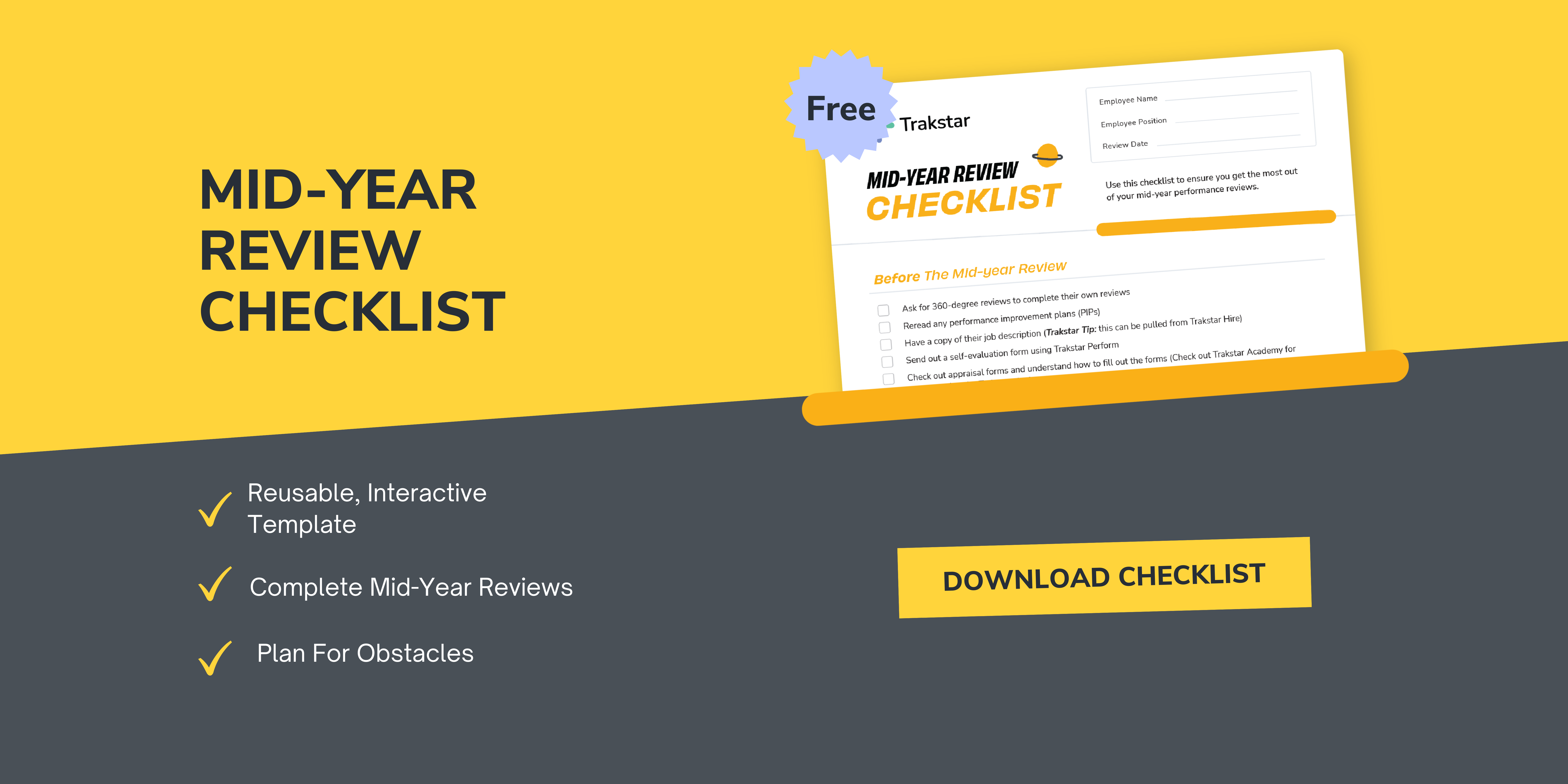Should Your Organization Do Quarterly, Mid-Year, or Annual Performance Reviews?
Posted by Trakstar • June 1, 2023 • 8 min read
What is the right cadence for performance reviews? Quarterly performance reviews? Mid-year reviews? Annual reviews only
Does it really matter? (Spoiler alert: yes)
We have some suggestions if you need help deciding when to conduct performance reviews for your employees. Our performance review software has changed how Human Resources professionals, managers, and employees view the review process.
In this blog post, we will explore the pros and cons of each type of review and help you determine which approach is best suited for your organization. By the end of this article, you’ll know when to schedule employee evaluations and how to make them successful – maybe even with a bit of help from Trakstar Perform.
The Quarterly Performance Appraisal
The quarterly review is a performance evaluation process that occurs every three months or roughly around the end of the quarter for your organization. This type of review can help employers monitor their employees’ progress and offer real-time feedback. If you are a growing organization, it can help to have a review meeting to ensure that everyone is aligned – perhaps even having a department goal-setting meeting or roundtable to just have a conversation about what is expected. The department head should come to these meetings with an idea of what to discuss and what everyone should have as goals.
One of the benefits of conducting quarterly reviews is that it allows managers to catch issues early on before they become significant problems. By checking in with employees regularly, managers can provide guidance and support when needed. For younger employees or those learning new core competencies, these regular reflections can be extremely helpful.
Another advantage of this approach is that it helps maintain momentum throughout the year. With regular check-ins, employees are more likely to stay engaged and motivated, ultimately leading to better results for the company. Check-ins don’t have to be
formal performance evaluations, however. You can run them as simple meetings but still take notes about achievements, conversations, improvements, and concerns. Supervisors can refer to these notes as they do a more formalized performance review.
Quarterly Review Concerns
However, there are also concerns when doing quarterly reviews. For example, some argue that conducting evaluations too frequently can be overwhelming or redundant for both employers and employees. If you are concerned about an employee’s performance, then it may be time to set up a PIP or have performance discussions. However, for the large majority of your employees, running an engagement survey or a manager check-in should suffice.
Whether you conduct quarterly reviews depends on your organization’s needs and goals. While it may only be necessary for some, this method could be beneficial if used correctly.
The Mid-Year Review
The mid-year review is a performance evaluation that takes place halfway through the year. This review ensures that employees stay on track with their goals and objectives while giving them an opportunity to discuss any challenges they have faced. Now, it’s important to note that this could mean one of two things:
- It could be halfway through an employee’s year, or six months after their work anniversary.
- It could be halfway through the fiscal year for your organization.
Whichever one works best for your company is the one that you should follow when having performance discussions.
One of the benefits of a mid-year review is its flexibility. Unlike annual reviews, it allows for changes to be made in real time, which can help employees improve their performance and reach their goals more efficiently.
It’s also an excellent time for managers to provide feedback on employee progress and adjust expectations if necessary. Employees can use this feedback as motivation to continue performing well or make changes where needed. Most people are more casual about the mid-year performance review than the annual performance review.
Six months is still a lot of time, particularly in the fast-moving industry. Having a mid-year review helps employees know they are on the right track when it comes time for annual performance reviews. It also gives them enough time to make changes (and see if they stick!).
To learn more about mid-year reviews, we have an entire guide here.
Concerns About Mid-Year Reviews
However, some may argue that a mid-year review needs to be more comprehensive since it only covers half the year. It’s important to remember that this type of review is not necessarily to evaluate an entire year’s worth of work but rather to assess progress thus far.
Conducting a successful mid-year review requires clear communication between both parties and setting realistic goals for the remainder of the year. It works as part of a performance management program and is effective in most organizations – the debate is truly whether or not it is as formalized as the annual review process.
The Annual Performance Review
The annual review is one of the most common types of performance reviews. It typically happens once a year and provides a comprehensive overview of an employee’s work over the past 12 months. An annual evaluation is a must-have in our minds.
One advantage of an annual review is that it allows for a big-picture view of an employee’s performance. This can be helpful in identifying trends, patterns, and areas where improvement may be needed. Additionally, because this type of review covers a longer period, it provides more data points to draw from when making evaluations.
There are many ways to make annual reviews even better! Ensuring that everyone in the organization is aligned and adhering to specific KPIs, using 360-degree reviews, tying reviews to learning opportunities, and setting yearly goals all benefit employee performance and retention efforts.
Are There Downsides to Annual Reviews?
However, there are also some potential downsides to annual reviews. Because they cover such a long period, issues or accomplishments may get forgotten or overlooked. Additionally, feedback provided during an annual review may not be as timely as feedback given through other formats.
Despite these potential drawbacks, many companies still choose to conduct annual reviews due to their thoroughness and ability to provide employees with a clear sense of how they’re performing overall. Ultimately, whether you opt for quarterly, mid-year, or annual reviews will depend on your company’s culture and needs.

Pros and Cons of Each Type of Employee Performance Review
Each type of review has its own set of advantages and disadvantages. Quarterly reviews provide a regular check-in to ensure that employees are on track with their goals, but they can also be seen as too frequent and time-consuming. Mid-year reviews allow for more in-depth feedback and goal-setting, but there is a risk of losing momentum between the mid-year and annual reviews.
Annual reviews give employees a comprehensive assessment of their progress over the course of an entire year, but it may not be enough to address issues that arise throughout the year.
Quarterly reviews can help identify areas where additional training or support is needed early on, while mid-year reviews offer an opportunity to adjust goals midway through the year based on performance thus far. Annual reviews can serve as a benchmark for promotions or salary increases.
On the other hand, quarterly and mid-year reviews may feel like incomplete assessments since they do not cover an employee’s entire work history from the previous year. Additionally, annual reviews have been criticized for being overly formal and lacking specificity in feedback. Investing in a good performance management solution can be helpful in getting you out of that rut.
Ultimately, deciding which type of review to implement depends on company culture and individual preferences. It’s important to strike a balance between providing regular feedback without overwhelming employees with constant evaluations.
When is the Best Time for Employee Reviews?
When it comes to conducting performance reviews, timing is an important factor. Timing ensures that employees receive feedback regularly and allows for the necessary adjustments to be made in a timely manner. But when exactly is the best time for a review?
For quarterly reviews, it’s recommended to schedule them at the end of each quarter or every three months. This allows enough time between reviews for there to be significant progress while still providing regular feedback.
Mid-year reviews should be conducted six months after the employee’s annual review. This serves as an opportunity to discuss any issues that have arisen since their last evaluation and set goals for the second half of the year.
Annual reviews are typically conducted around the anniversary date of employment. It provides ample time to evaluate employee performance over a longer period while also discussing career growth opportunities.
Ultimately, finding what works best depends on your organization’s culture and needs. Scheduling frequent check-ins can help with continuous improvement, while less frequent evaluations allow more time for reflection and goal-setting.
Better Annual Performance Reviews Are Possible
The decision of whether to do quarterly, mid-year, or annual reviews depends on various factors. Each type of review has its advantages and disadvantages. Quarterly reviews help maintain focus on goals and provide frequent feedback, but they can be time-consuming for managers. Mid-year reviews offer a chance to assess progress and adjust plans if needed, but they may not always address issues in real time. Annual reviews provide an opportunity for a comprehensive analysis of performance over the year, but it may be too late to address problems by then.
Ultimately, the best approach is to determine what works best for your organization’s culture and needs. A successful review requires careful planning, clear communication with employees about expectations and objectives beforehand, active listening during the meeting itself as well as follow-up discussions after the completion of each review cycle.
Regularly conducting effective employee evaluations at whatever frequency you choose will lead to improved employee morale that ultimately leads to better business outcomes.
Don't Miss Out on More Great HR Articles!
Subscribe to get the latest, greatest HR and Talent Development content straight to your inbox.



